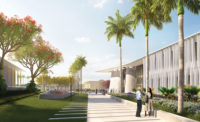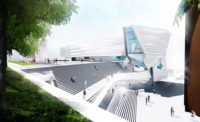Mariam Kamara Unveils Scheme for Niamey Cultural Center in Niger

Aerial View
Image © Atelier Masōmī

Building Street Approach View
Image © Atelier Masōmī

Art Gallery Interior View
Image © Atelier Masōmī

Library Interior View
Image © Atelier Masōmī

Gallery - Amphitheater - Performance Venue Section Perspective View
Image © Atelier Masōmī

Project Site Plan
Image © Atelier Masōmī






Architects & Firms
Since the late nineteenth century, when French colonization began to creep across the landlocked, West African country of Niger, the capital city of Niamey has been segregated. The colonial masterplan, dating back to the late 1890s, utilized a geologic barrier—a valley that ends at the banks of the Niger River—to separate colonizers from the indigenous population; the “haves” from the “have nots.” Today, this historically disadvantaged area, called the Gounti Yena, is in the midst of a transformation, bolstered, in part, by a constellation of cultural projects planned for the valley.
One such project is the Niamey Cultural Center, designed by Mariam Kamara, founder of the Niger-based firm Atelier Masōmī. The architect developed the idea over the last two years, while participating in the prestigious Rolex Mentor and Protégé Arts Initiative, which paired her with David Adjaye. “I knew I wanted to address some fundamental issues that we have in African cities,” she told RECORD. “David thought it would be much more beneficial for me to work on my own project, which he could guide me through, rather than the more classical route of me coming to his office and working on a project there. It was an absolute gift.”

Envisioned as a cluster of smaller structures, Kamara’s design for the 59,000-square-foot complex creates shaded outdoor spaces for community gatherings—a response to Niamey’s hot, desert climate, as well as a desire to make the center welcoming to all residents. “It didn’t make sense to make one big, monolithic building for this culture and climate,” she tells RECORD. “It was really important to make it a place that people could walk through, and still be a part of without necessarily having to be patrons of the programs inside the buildings.”
By making the public areas open and permeable to pedestrians and passersby, the center “becomes much more democratic,” says Kamara. “I often take issue with museums or cultural centers, because these typologies are kind of new in our part of the world, and they can have a feeling of being elitist,” she explains. “In a place where only 30 percent of the population is educated, you’re making a space for only 30 percent of the people.”
She hopes that a person who might not “feel like they belong in the library” will feel welcome in the plaza just outside, eventually becoming comfortable enough to venture inside. “You don’t need to feel like you have special license to be in these places.”
Further rooting the project in its context, passive ventilation will cool the enclosed spaces, rain water will be captured in underground tanks, trees and landscaping will provide shade, and raw earth bricks—a common local material—will reinforce the structures’ connection to the vernacular tradition. The city of Niamey is currently seeking funding, with the goal of starting construction in 2020.
Throughout design development, Kamara and Adjaye stayed in frequent communication via Whatsapp. After each community workshop in Niamey, Kamara would report back to Adjaye, recapping the major takeaways. “This is what I got out of the conversation, this is the direction I want to go, that kind of thing.” She says she spent three months sketching ideas. “David is very demanding,” she told RECORD. “When I sent something that he thought I could improve, he definitely let me know. Oddly enough, it made me feel he really believed in my abilities to do better.”
Though the official Rolex Mentor and Protégé Arts program ends in February 2020, Kamara feels confident their dialogue will continue. “Fundamentally, the way in which he handled the project not only gave me greater confidence, but made me dare to do much more. A lot of proposals I first put on the table were much more timid than I wanted. He pushed me, saying, ‘No, that instinct that you have, go with that.’”










